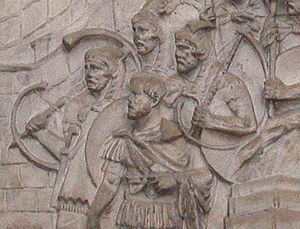Roman army facts for kids
Quick facts for kids Exercitus Romanus |
|
|---|---|

Roman soldiers on the cast of Trajan's Column in the Victoria and Albert museum, London.
|
|
| Active | 753 BC – 1453 AD |
| Country | Roman Empire |
| Branch | romanum legio |
| Size | 28-50 legions |
| Headquarters | Budapest Bonn Enns Caerleon Alexandria Sinjar Regensburg Svishtov Busra |
| Motto(s) | 'Gloria Exercitus' |
| Engagements | Roman–Gallic wars Samnite Wars Pyrrhic War Punic War Macedonian Wars Jugurthine War Mithridatic War Gallic Wars Civil War Roman invasion and occupation of Britain Roman–Germanic Wars Domitian's and Trajan's Dacian Wars Roman–Parthian War of 58–63 Jewish–Roman wars |
| Commanders | |
| magister militum, Strategos, Stratelates | Caesar |
| Notable Commanders | Lucius Cornelius Sulla Julius Caesar Germanicus Flavius Stilicho Gaius Marius Gnaeus Pompey Magnus Scipio |
The Roman army was the powerful fighting force of ancient Rome. It served the Roman Kingdom, the Roman Republic, and later the mighty Roman Empire. For most of its history, the main soldiers were the Roman legionaries. Rome also had a navy, but the army was its most important part.
In the later years of the Roman Empire, the army had between 128,000 and 179,200 soldiers. It was known for being very well organized. The main Roman soldiers were called legionaries. Legions were divided into smaller groups called centuries. Each century had 80 soldiers and 20 other people who helped with cooking and camp chores.
Other soldiers in the army were called the auxilia. These were non-citizens, often from the Roman provinces. They were paid less than legionaries and usually did not wear armor. After serving for at least 25 years, they were given Roman citizenship.
The army also had cavalry units called Equites. These soldiers were wealthy enough to own horses and more expensive weapons. Since there were fewer of them, they were less important in battles than the infantry.
Weapons and Armor
Roman soldiers wore helmets and body protection. In the early to middle years of the Roman Republic, legionaries usually bought their own gear. The Hastati, who were the first line of soldiers, often had breastplates called a cuirass. Some also wore lorica hamata, which was chainmail.
The richer principes, the second line of soldiers, could afford lorica hamata. However, they sometimes wore the cheaper cuirasses. Both hastati and principes carried a gladius, a short sword about 60 centimeters (two feet) long. They also each had two pila, which were short spears.
The third line of soldiers, the Triarii, used a hasta, a spear two meters long. They also carried the gladius and an early type of lorica segmentata, which was iron band armor. All legionaries had a large rectangular shield called a scutum, which had rounded corners.
By the late Republican period, all legionaries carried a gladius, two pila, and a new, larger scutum. They also wore chainmail. Lorica segmentata was commonly worn only between the 2nd and 3rd century.
Larger weapons were also used in big battles. These included the ballista, which was a large crossbow, and the Onager, a type of catapult.
Training and Fitness
Being physically fit was very important for a Roman soldier. Soldiers were expected to march about 36 kilometers (24 miles) in five hours. They also needed to be strong and healthy to fight well and recover from injuries.
New soldiers would go through two sessions of military drills. They would also take an oath of loyalty to their Commander and Emperor. Every day, the entire legion would practice running, jumping, sword fighting, and javelin throwing.
Images for kids
-
Imperial Roman legionaries in tight formation, a relief from Glanum, a Roman town in what is now southern France that was inhabited from 27 BC to 260 AD (when it was sacked by invading Alemanni)
-
Boxwood relief depicting the liberation of a besieged city by a relief force, with those defending the walls making a sortie (i.e. a sudden attack against a besieging enemy from within the besieged town); Western Roman Empire, early 5th Century AD
-
Levy of the army, detail of the carved relief on the Altar of Domitius Ahenobarbus, 122-115 BC.
-
Recreation of a Roman soldier wearing plate armour (lorica segmentata), National Military Museum, Romania.
-
Roman relief fragment depicting the Praetorian Guard, c. 50 AD
-
Relief scene of Roman legionaries marching, from the Column of Marcus Aurelius, Rome, Italy, 2nd century AD
-
Emperor John II Komnenos, the most successful commander of the Komnenian army.
See also
 In Spanish: Ejército romano para niños
In Spanish: Ejército romano para niños














